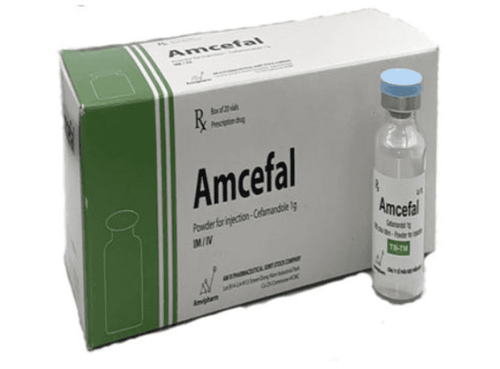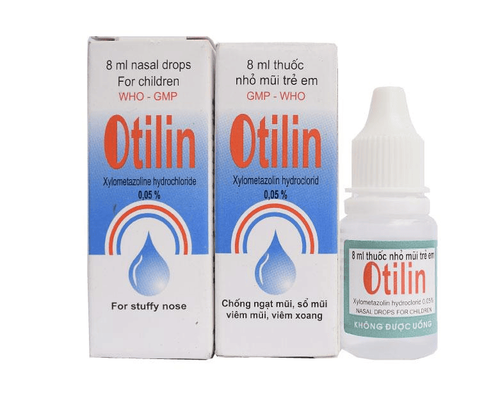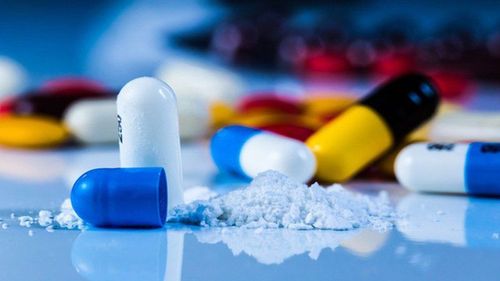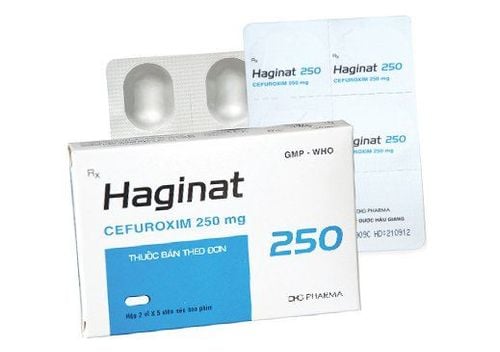This is an automatically translated article.
Tiafo is an injectable antibiotic that is used to treat a number of bacterial infections. So what exactly does Tiafo treat and how to use this drug?1. What disease does Tiafo treat?
Tiafo drug is made in the form of a powder for injection, the main ingredient in each vial of the powder is Cefotiam 1g in the form of Cefotiam sodium and sodium carbonate. Each solvent tube contains 15ml of distilled water for injection.
Cefotiam is a third generation Cephalosporin antibiotic. This active substance has a strong affinity for Penicillin-binding proteins 1 and 3 (this substance is necessary for the growth and division of bacteria). Thus, the drug has the effect of killing bacteria through the mechanism of inhibiting the synthesis of bacterial cell walls.
Cefotiam is stable under the action of beta lactamase enzyme. Types of bacteria sensitive to Cefotiam include:
Gram-positive bacteria include: penicillin-sensitive Staphylococcus, Group A, B, C, G Streptococcus...; Gram-negative bacteria include: E.Coli, Haemophilus influenzae, Citrobacter koseri, Proteus mirabilis, Proteus vulgaris, Provisenciar, Klebsiella, Branhamella catarrhalis; Anaerobic bacteria include: Fusobacterium, Peptostreptococcus, Prevotella; Cefotiam has no effect on Pseudomonas aeruginosa, Enterobacter cloacae. Tiafo is indicated in the following cases:
Sepsis; Chronic bacterial skin infections; Infections deep in the skin; Infection of burns, postoperative wounds; Secondary infection of pneumonia, lung abscess; Purulent swelling, chronic damage to the respiratory tract; Meningitis ; Sinusitis; otitis media; Uterine conjunctivitis; Uterine infection; Bartholin gland inflammation ; Cystitis; Kidney disease; Acute and chronic prostatitis; Peritonitis; Cholecystitis. Tiafo is contraindicated in the following cases:
People with hypersensitivity to any antibiotic of the Cephalosporin group; People who are hypersensitive to anesthetics, local anesthetics of the Aniline group such as Lidocaine; Do not use Tiafo intramuscularly in children. Care should be taken when using Tiafo on the following subjects:
People with a history of allergy to Penicillin; People with allergies or family members with allergies; Patients with severe renal failure; The elderly, malnourished, people with weakened health, receiving parenteral nutrition; Monitor hematology when using the drug because patients may experience hemophilia due to lack of vitamin K; If the patient develops colitis during treatment, the drug should be stopped immediately and appropriate treatment measures should be taken; Tiafo causes false positive in Coombs test, urine glucose test with reducing agent method; Tiafo resistance can occur with long-term treatment.
2. Dosage and administration of Tiafo
The way to use Tiafo is as follows:
Tiafo is used by intramuscular injection, injection or intravenous infusion; Cefotiam is not compatible when mixed with solutions of bromhexin HCl 2mg/2ml, Dipyridamole 5mg/2ml or 5mg/ml, Gabexate mesilate 100mg/vial; Intravenous injection:
Dissolve 1g of Cefotiam with 10ml of distilled water for injection to get a solution with a concentration of 100mg/ml; Dissolve 1g of Cefotiam with 5ml of 0.9% NaCl solution or 5% Dextrose to obtain a solution with a concentration of 200mg/ml. Intravenous infusion:
Dissolve 1g of Cefotiam with 100ml of 0.9% NaCl solution or 5% Dextrose to get a solution with a concentration of 10mg/ml.
Then use the intravenous collection solution for 30 minutes to 2 hours.
Tiafo drug solutions after reconstitution are stable within 12 hours at room temperature 25±2 degrees Celsius and for 24 hours if stored at 5±2 degrees Celsius.
Dosage of Tiafo is adjusted to appropriate for each patient's age and disease status. The recommended dose for specific cases is as follows:
Adult dose of Tiafo:
Most infections: Use dose 0.5-2g/day, divided into 2-4 doses spaced every other day. 6 o'clock or 12 o'clock; In sepsis, the dose of Tiafo may be increased to 4 g/day intravenously. Dosage of Tiafo for children:
The usual dose is from 40-80mg/kg/day, divided into 3-4 times 6-8 hours apart; In case of sepsis, meningitis: The dose of Tiafo can be increased up to 160 mg/kg/day. Dosage of Tiafo for patients with renal failure:
Creatinine clearance > 20ml/min: Use normal dose, maximum dose 400mg/day. Creatinine clearance < 20ml/min: Use dose = 1/4 of the usual dose with an interval of 6-8 hours or use the normal dose if the dosing times are 12 hours apart. Symptoms of Tiafo overdose include: Nausea, vomiting, epigastric pain, diarrhea, convulsions. Currently, there is no specific antidote to Tiafo, so it is mainly a supportive treatment to relieve symptoms.
3. Side effects of the drug Tiafo
During the use of Tiafo, you may encounter some side effects of the drug.
Less common side effects of Tiafo include:
Dizziness; Headache; Uncomfortable; Stomachache; Diarrhea; Stomatitis ; Bacterial superinfection. Rare side effects of Tiafo include:
Nausea, vomiting; Pseudomembranous colitis ; Lack of vitamin K, vitamin B; Increased liver enzymes; Hematological disorders; Shock, hypersensitivity; Steven-Johnson syndrome ; CKD; Temporary increase in neutrophils and eosinophils. If you experience any side effects of Tiafo, you need to tell your doctor immediately, or immediately go to the nearest medical facility for timely treatment.
4. Interactions of Tiafo with other drugs When Tiafo is used together with potent diuretics such as furosemide or other cephalosporin antibiotics, there is an increased risk of impaired renal function.
Above are the uses, how to use and note when using Tiafo. Patients should not self-medicate, but should consult a doctor or pharmacist before use.
Please dial HOTLINE for more information or register for an appointment HERE. Download MyVinmec app to make appointments faster and to manage your bookings easily.













